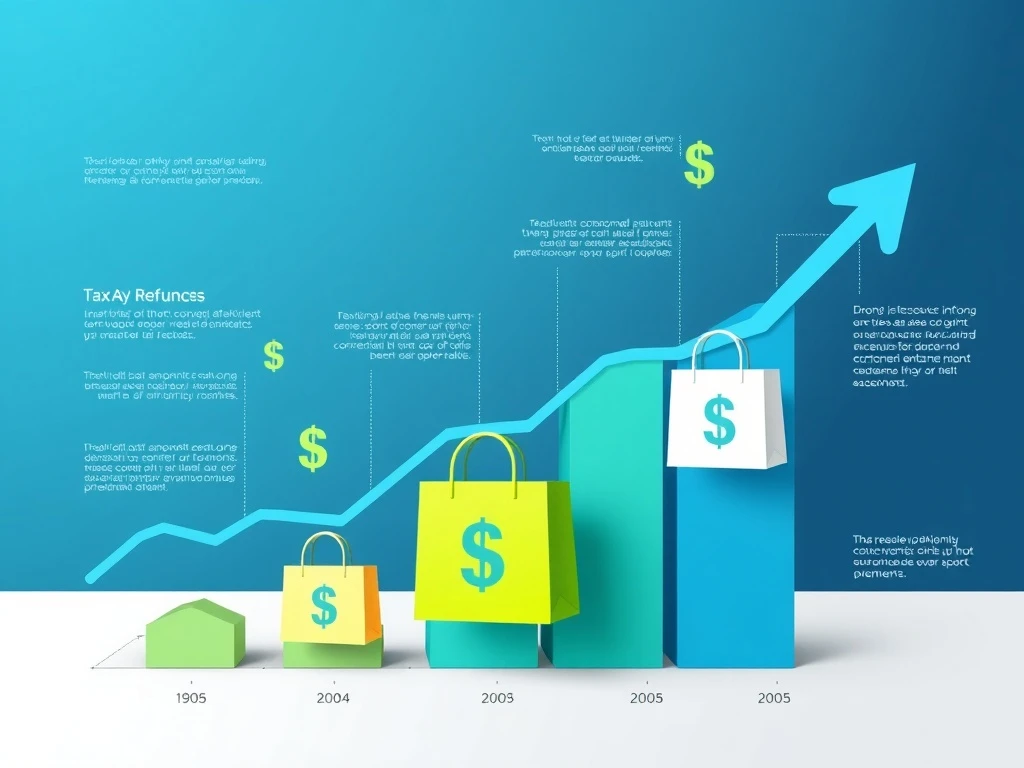JPMorgan analysts project an unprecedented tax refund surge that will inject billions into the economy, potentially reshaping consumer behavior and market dynamics throughout 2024. This massive influx of funds arrives at a critical juncture for both Main Street and Wall Street.
Understanding the Tax Refund Surge Phenomenon
JPMorgan’s research indicates this tax refund surge will exceed previous records significantly. The banking giant anticipates refund amounts will increase by approximately 15-20% compared to last year. This projection stems from several key factors:
- Policy changes affecting withholding calculations
- Economic recovery patterns boosting overall incomes
- Legislative adjustments from recent tax reforms
Consequently, millions of Americans will receive larger refund checks. This development creates substantial economic implications.
Economic Impact of the Refund Wave
The tax refund surge will directly stimulate consumer spending across multiple sectors. JPMorgan’s analysis shows that approximately 70% of refund recipients typically spend their refunds within the first three months. This spending pattern generates:
- Retail sales increases of 8-12%
- Service industry growth of 6-9%
- Durable goods purchases rising 10-15%
This injection of capital occurs during a crucial economic period. It potentially offsets other economic headwinds effectively.
Market Implications and Investment Shifts
JPMorgan expects the tax refund surge to influence market behavior substantially. Historical data reveals that refund seasons often correlate with:
- Increased retail investment activity
- Higher small-cap stock performance
- Consumer cyclical sector outperformance
Furthermore, the banking giant predicts specific market sectors will benefit disproportionately. These include consumer discretionary, retail, and financial services stocks.
Sector-Specific Analysis and Projections
JPMorgan’s sector analysis identifies clear winners from this tax refund surge. The research team projects exceptional performance in:
- Automotive industry – expecting 5-7% sales boost
- Home improvement – anticipating 8-10% growth
- Electronics retail – forecasting 12-15% increase
These projections assume normal economic conditions persist. They also consider current consumer confidence levels carefully.
Regional Economic Variations
The tax refund surge will affect regions differently according to JPMorgan’s geographical analysis. States with higher average incomes typically see larger refund amounts. However, spending patterns vary significantly by region:
- Northeast – higher allocation to savings and investment
- Midwest – increased spending on durable goods
- South – stronger service sector expenditure
- West – greater technology and experience spending
These regional differences create diverse economic impacts nationwide.
Long-Term Economic Implications
JPMorgan emphasizes that this tax refund surge could have lasting effects beyond immediate spending. The analysis suggests potential outcomes including:
- Sustained consumer confidence improvements
- Increased household debt repayment rates
- Higher savings rate momentum continuation
- Improved credit scores across demographics
These factors collectively contribute to broader economic stability. They also support continued growth throughout the year.
Risk Factors and Considerations
Despite optimistic projections, JPMorgan acknowledges several risk factors surrounding this tax refund surge. Key considerations include:
- Inflation impacts on purchasing power
- Geopolitical uncertainties affecting markets
- Potential policy changes during tax season
- Consumer sentiment shifts from external factors
These variables could moderate the expected economic benefits significantly. Investors should monitor developments closely.
Investment Strategy Recommendations
Based on their tax refund surge analysis, JPMorgan recommends specific investment approaches. The firm suggests overweight positions in:
- Consumer discretionary ETFs
- Regional bank stocks
- Retail real estate investment trusts
- Payment processing companies
These sectors historically benefit most from increased consumer spending. They also show strong correlation with refund cycles.
Conclusion: Navigating the Refund-Driven Economy
The anticipated tax refund surge represents a significant economic event with far-reaching implications. JPMorgan’s comprehensive analysis provides valuable insights for consumers, investors, and policymakers alike. Understanding these dynamics helps stakeholders make informed decisions during this period of increased economic activity.
Frequently Asked Questions
What makes this tax refund surge different from previous years?
This year’s tax refund surge features unusually large average refund amounts due to specific policy changes and economic recovery patterns. JPMorgan projects refunds will be 15-20% higher than previous years.
How quickly do consumers typically spend their tax refunds?
Research indicates approximately 70% of recipients spend their refunds within the first three months, with the majority of spending occurring in the first six weeks after receipt.
Which market sectors benefit most from tax refund surges?
Consumer discretionary, retail, automotive, and home improvement sectors typically see the strongest performance during refund seasons according to historical data analysis.
Could inflation reduce the economic impact of larger refunds?
While inflation may somewhat reduce purchasing power, the substantial increase in refund amounts is expected to outweigh inflationary pressures for most consumers.
How does JPMorgan track the economic impact of tax refunds?
JPMorgan uses multiple data sources including consumer spending surveys, retail sales data, credit card transaction analysis, and regional economic indicators to measure impact.
Should investors adjust their strategies based on refund projections?
JPMorgan recommends considering seasonal allocation adjustments toward consumer-focused sectors but emphasizes maintaining diversified long-term investment strategies.








